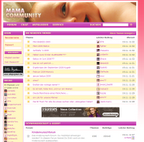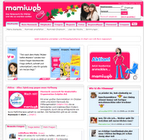 Neue Social Networks und Online Communities für Frauen, Mütter und Eltern schießen schneller aus dem Boden als man den Überblick behalten kann. Die Zielgruppen sind finanziell potent und offen für neue Produkte. Wer z.B. aus Absatzsicht wissen will, wo sich Eltern auf Communities tummeln, sollte sich diese ausführliche Übersicht der Eltern-Plattformen mal ansehen.
Neue Social Networks und Online Communities für Frauen, Mütter und Eltern schießen schneller aus dem Boden als man den Überblick behalten kann. Die Zielgruppen sind finanziell potent und offen für neue Produkte. Wer z.B. aus Absatzsicht wissen will, wo sich Eltern auf Communities tummeln, sollte sich diese ausführliche Übersicht der Eltern-Plattformen mal ansehen.
Was die Zielgruppen Frauen und Mütter angeht, so finden hier mal ein paar interessante Plattformen ein wenig mehr Beachtung, die wahrlich viel Gründe und Potential für Werbeeinsätze liefern: ein Social Network für die moderne mobile Frau, zwei Communities für (auch werdende) Mütter und das neue Corporate Community des Kinderwagen-Produzenten Bugaboo. Die Auswahl beruht darauf, dass diese Plattformen teilweise neu sind, teilweise nicht IVW gelistet oder klar positioniert – aber sich dennoch großer Beliebheit erfreuen.
Neue Community Plattformen
 shesconnected.com
shesconnected.com
Women and Businesswomen united – das Sex and the City Netzwerk? Nun kommt also die exklusive Plattform für die Frau und man frägt sich, ob nicht eine persönliche Präsenz auf XING, LinkedIn oder Facebook genügt? Nein, denn so die Plattform… “No other site allows women to create both a personal and professional profile. Keep one private, make the other public.” Man(n) frägt sich automatisch: Gibt es eigentlich für Männer schon eine ‘hesconnected’ Community, oder brauchen Männer ein geschlechtsspezifisches Social Network nicht? Für Frauen positioniert sich das Social Network als …
“…the one place where busy women can connect with others to find the tools, tips and resources to simplify everyday life on the go. Whether juggling family, career or both, now women can stay connected to who and what matters most.”
Ein aus Business- und Finanzierungs-Sichtweise sicherlich guter Ansatz ist das Shesconnected Publishers Network, welches talentierten Bloggern und der ‘publizierenden’ Menschheit die Option bietet, Content in die Plattform einzubringen und der mobilen Frau interessante Inhalte zu offerieren. Ein cleverer Web 2.0 Ansatz: Nicht die Plattform muss für Content sorgen, sondern die Community selbst – oder eben diejenigen, die den Zugang zur Frau suchen.
 bugaboofriends.com
bugaboofriends.com
Diesen Monat launched Bugaboo seine weltweite, lokalisierte Online Community: Bugaboo Friends – eine Community für Eltern, Großeltern, Freunde der Marke und allen mobilen ‘Kinderwagenschubsern’. Dort sollen Geschichten ausgetauscht werden, Produkte vorgestellt und Tricks gezeigt werden, sowie Fotos und Videos von Bugaboo Begeisterten aus aller Welt hochgeladen werden. Bugaboo fordert die Mitglieder zu Bewegung auf, neue Örtlichkeiten zu erforschen und stellt selbst Tagestrips vor. Natürlich gibt es für Commmunity Mitglieder alle Neuigkeiten um das Brand und die Company zuerst. Und die Community wartet mit einem Statement auf, welches werdenden Eltern ein neues modernes und mobiles Leben aufzeigt.
“Just because you become a parent doesn’t mean you have to stop exploring.”
Dieses Statement, die Geschichte um die Funktionalität und die Filmfeatures der Kampagne machen eine solche Online Community zu einer runden Sache – empfehlenswert für alle, die sich mit dem Gedanken tragen, eine Corporate Community Plattform zu schaffen.
Community Plattformen für Mütter
 mamacommunity.de
mamacommunity.de
Die Community für die Mama – eine von vielen neben der offensichtlich marktführenden Plattform netmoms.de (Oktober 2008: 18 Mio. PIs). Auf mamacommunity wird alles besprochen, was rund um Schwangerschaft, Baby, Kinder, Familie, Schwanger werden und Geburt geht. Die eigene Bezeichnung ‘Die Online-Community für Mütter, Schwangere & Co.’ klingt irgendwie herrlich – denn was oder wer ist ‘Co.’ (Papa?). Der Mitteilungswille und Kommunikationsaustausch unter Frauen ist bekannt – unter Mütter ist er immens … und im Wachstum. Da macht es anscheinend auch nichts aus, dass die Plattform gar nicht groß auf eine Beschreibung oder Positionierung setzt (außer die paar Google Metas) – eine ‘Über uns’ Seite fehlt gänzlich, ist für die Mütter aber wohl nicht wichtig. Es wurden inzwischen über 1 Mio. Beiträge (!) geschrieben. Für Frauen zählt anscheinend, dass gesprochen, diskutiert und mitgeteilt wird – eben der Grundgedanke einer Community. Was die Vermarktung der Seite betrifft, so sucht man Angaben hierzu gänzlich – auch wenn sich Banner auf der Seite finden.
 mamiweb.de
mamiweb.de
Im Mai 2007 gestartet hat mamiweb.de inzwischen über 175.000 Mitglieder. So zitiert Perspektive-Mittelstand einen der Mitbegründer: „Mamiweb ist der Konkurrenz mittlerweile meilenweit voraus”, so Dr. Gerhard Öllinger, Geschäftsführer der Mamiweb GmbH in Frankfurt am Main. „Unser Angebot an Mütter und Schwangere ist so beliebt und bekannt, dass sich fast jede Minute ein neues Mitglied bei unserem kostenlosen Netzwerk registriert!”. Auf dieser Seite wird wahrlich an alles gedacht und erklärt. Natürlich auch Fotoaustausch, Regionaltipps und verschiedene Gruppen finden sich auf der Community-Plattform. Bei so viel Informationen und Austauschmöglichkeiten fägt man sich, ob ein Blog noch Not tut – nach Einsicht bietet dieser aber wahrlich hilfreiche Tipps für Mama und Papa. Vermarktet wird die Seite von GUJ Electronic Sales und so finden sich auch zahlreiche Banner auf der Seite.
Spot On!
Es ist faszinierend, wie unterschiedlich man Eltern, Mamas oder Frauen in unserer Web 2.0 Welt adressieren kann – mannigfaltig nach Geschlecht, nach Vorlieben, nach Selbstdarstellung oder Produktvorlieben. Für jede unterschiedliche Lebenssituatione kann man ein neues Gesicht aufsetzen. Wenn wir alle zwischen unseren Blogs, XING, LinkedIn, Social-, Privat-Interessen Networks oder -Communities hin- und herwandern, bleibt nur zu hoffen, dass wir da noch Zeit haben werden, reale Zwischenmenschlichkeit zu pflegen, unsere Kinder zu wickeln oder im Handel uns den begehrlichen Produkten der Zukunft und des handfesten Lifestyles zu widmen. Sonst haben wir bald SecondLife zur Realität gemacht… oder nicht?
 The latest report from Bredin Business Information (BBI) finds that SMB’s will not become customers with the common marketing strategies: Marketers are going online while small and medium-size companies are still living the offline world of direct mail and tradeshows.
The latest report from Bredin Business Information (BBI) finds that SMB’s will not become customers with the common marketing strategies: Marketers are going online while small and medium-size companies are still living the offline world of direct mail and tradeshows.







